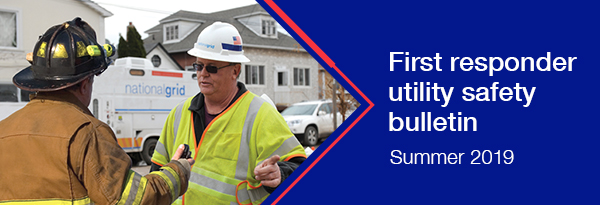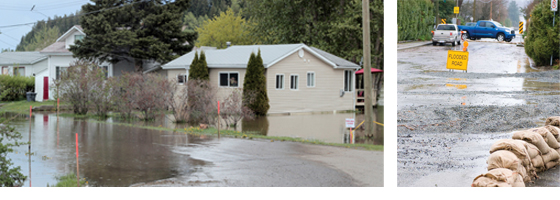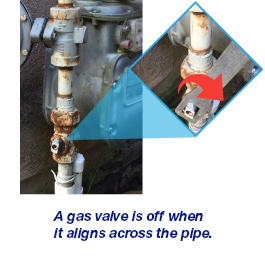 |
 |
Equipment and appliance hazards in flood events:
Your key response strategies
|
|
Recent occurrences indicate that flood events have become more common, more catastrophic and more dangerous to first responders. Preparation and a full understanding of potential hazards are key to a safe and successful response.
|
 |
|
When responding to any flood event, consider the hidden hazards posed by compromised electrical and natural gas equipment and appliances. Remember the fire service adage “risk a little to save a little, and risk a lot to save a lot.” Survey the incident scene to assess the level of risk, and do not subject yourself to significant risk to save flooded property or appliances. Instead, work with National Grid to safely isolate utilities and deactivate appliances impacted by floodwaters.
|
| The response strategies below can help your team not only prepare for impending flood events, but also respond safely when flooding is under way. |
|
|
| Preparation |
| When flooding is anticipated, take these steps: |
| 1. |
|
Advise residents of the impending flood. Communicate the relative hazard and assist residents in evacuating unsafe areas. |
| 2. |
|
If time permits, advise residents to seek professional assistance to move or secure electrical and gas equipment and appliances. This may include hiring licensed professionals to relocate appliances above the anticipated waterline or remove appliances from the hazard area. |
| 3. |
|
Coordinate with National Grid through your Incident Commander (IC) or emergency manager. Any action that impacts electrical or natural gas infrastructure must be clearly communicated to the utility. |
| 4. |
|
If flooding is imminent, National Grid may enlist first responders to secure electrical and gas service in areas likely to be impacted by floodwaters. In this case, take the following steps ONLY if you can accomplish them without entering floodwaters or touching equipment that has been exposed to floodwaters: |
|
| • |
|
Turn off electrical service by shutting off the circuit breakers, working from the bottom of the panel to the top. If the panel has a main circuit breaker, this should be the last to be secured. |
|
| • |
|
If you have been trained to do so, you may stop natural gas service by shutting off the service valve located on the piping coming out of the ground before the gas meter. (Do NOT operate underground valves.) |
| • |
|
Shut off all equipment and appliances likely to be affected: Unplug electrical appliances, and close the shut-off valves on gas equipment and appliance supply lines. |
|
| |
|
|
 |
|
| • |
|
Inform National Grid of the precise address and location of any gas valve that has been closed, whether on the gas meter or on an appliance supply line. |
|
| • |
|
Advise residents not to operate equipment or appliances affected by flood conditions. |
|
| • |
|
Inform residents that after utility systems and equipment have been thoroughly inspected and repaired, National Grid will restore service as soon as it can be done safely. |
|
|
|
|
| Actions to avoid: |
| • |
|
Do NOT rush into flooded areas. Never enter floodwaters to save a life until utilities have been secured. |
| • |
|
Do NOT enter floodwaters to save property. |
| • |
|
Do NOT operate flooded appliances. Recognize that appliances and equipment affected by floodwaters will need to be tested, repaired and inspected before use. |
| • |
|
Do NOT touch or disconnect an appliance if you must stand in water to do it. |
| • |
|
Do NOT enter flooded basements unless all utilities have been controlled and your IC indicates that it is safe to do so. |
|
|
|
| Mitigation |
| Take these steps to address hazardous conditions after flooding has occurred: |
| 1. |
|
Make rescue and evacuation your primary concern. If water has already entered a structure, focus on evacuating occupants and getting your team out safely. |
| 2. |
|
Always wear appropriate PPE. This will often include full turnout gear and SCBA. |
| 3. |
|
Be alert for hazardous materials, biological contamination and displaced animals in floodwaters. Assume that all floodwaters are contaminated and dangerous. |
| 4. |
|
Be alert for downed power lines. Consider ALL power lines to be energized and potentially dangerous at ALL times, unless informed otherwise by National Grid. Stay at least 30 feet away from downed distribution lines and 100 feet away from downed transmission lines. |
| 5. |
|
Always use a combustible gas indicator (CGI) to determine if natural gas is being released in the area. If a leak exists, work with National Grid personnel to obtain situational guidance and coordinate safe control of the situation. |
| 6. |
|
Approach each structure cautiously and consider all utility systems to be hazardous until proven safe. Recognize that National Grid will not restore natural gas or electric service until inspections have been completed and it is safe to do so. |
| 7. |
|
Advise residents to confirm equipment and appliances are safe for use before operation. Vent lines for dryers and water heaters must be unblocked and properly connected to the outside. Appliances affected by floodwaters must be replaced or repaired by a qualified professional before operation. |
| 8. |
|
Be alert for carbon monoxide hazards from improperly ventilated backup generators. Generators must be used outdoors only, away from windows and doors. |
|
|
| Case in point: |
| First responders avoid electrocution in Indiana basement |
 |
| A woman was electrocuted while standing in the flooded basement of her home near South Bend, Indiana. County police and firefighters who arrived at the home were unable to immediately access the victim, as the area remained energized. Responding crews assessed the incident scene and concluded that standing water in an energized environment posed a high-risk shock hazard. After working with the utility company to cut power to the home, lifesaving crews started CPR and were able to restore a pulse. Sadly, the victim died at the hospital two days later. An investigation revealed that a plugged in box fan was the source of this tragedy. |
| |
|
|
A local assistant police chief said “It doesn’t help anyone if first responders, police and firefighters wind up becoming subsequent victims by rushing in to unsafe areas.” In this case, first responders acted appropriately, working as a team with
the utility company to control the hazard and reduce the level of risk prior to entering the area.
|
|
|
| Learn more gas and electrical utility response tips at firstresponder.ngridsafety.com. |
|
National Grid’s free First Responder Utility Safety Training Program has helped thousands of emergency response personnel learn to operate safely during incidents involving utility hazards. This program, which includes gas and electric certification trainings, covers natural gas pipelines and electric power lines as well as other facilities.
|
|
Through this training, you will gain the knowledge, skills and technical ability required to respond to the most common electrical and natural gas emergencies.
|
|
Our certification programs are self-paced. Users who complete the gas and electric programs will earn personalized certificates of completion.
|
|
|
Keep yourself, your team and the public safe this summer. Register today, and complete your utility safety training.
Visit firstresponder.ngridsafety.com. |
|
|
| To report emergencies, call 911 and National Grid immediately. |
|
| In case of gas emergencies: |
| Long Island and the Rockaways: |
|
|
|
|
|
|
|
|
|
|
|
| In case of electric emergencies: |
| Upstate New York: |
|
|
|
|
|
|
|
|
|
|
|
|
 |
| #11515 © 2019 Culver Media, LLC |
|
|